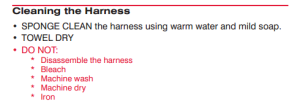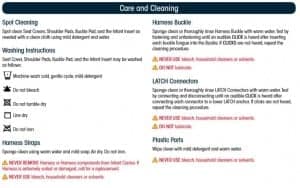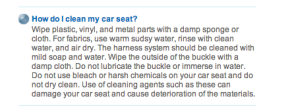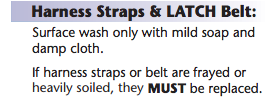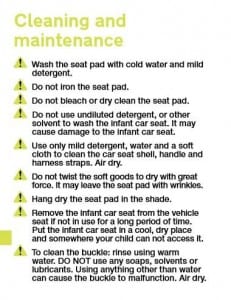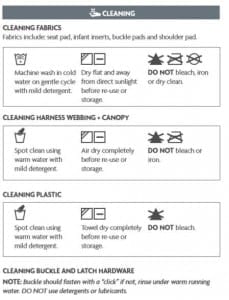As a CPST, over the years I’ve had more than a few parents contact me with a tale of bodily function woe. Their potty training children have had unspeakable accidents. A bout of car sickness left the seat looking like a sea of cottage cheese. In one memorable case, a skunk sprayed the seat. (And in case you’re wondering, if a skunk sprays the seat, you’re pretty much out of luck.)
As a parent myself, I know the feeling. You’re driving along, and hear the unmistakable ‘urp’ from the back seat. You white knuckle it until you find a safe place to pull over, but, too late, and you are left with a terrible, awful, no good, very bad mess to clean up.
Uncleanable Situations
We absolutely respect every caregiver’s right to attempt to clean any mess that comes their way. Sometimes, trashing a seat just isn’t an option and you have to make it work. However, we’ve found a number of scenarios where removing the stain or the smell is nearly impossible, even after following the manufacturer’s instructions to the letter. Here’s a short and kind of gross list of those bad, bad times for car seats: mold, animal urine or feces (most often, cat), fire, bedbugs, broken glass, skunks, bears, large spider nests, bees, certain parasitic infestations or infections, human waste if it’s too large in volume or has a chance to set into the seat.
Sometimes, the seat’s shell can be saved even if the cover cannot. Manufacturers usually sell replacement covers so you may be able to order one and get some more use out of the car seat.
Safe Cleaning Methods
The question you are left with is, ‘how do I clean this thing?’. Some parents jump in with both hands and a bottle of bleach. At the end, they are left with an entirely clean, and entirely unusable seat. Other parents mistakenly believe that the car seat is a delicate flower that cannot tolerate any sort of cleaning at all. They anxiously wonder if they should simply replace the seat for a minor spill of a cup of water.
As always, your number one resource is your child restraint’s manual. Every manual will have instructions on cleaning the seat, and do’s, and don’ts.
Here at CSFTL, we want to give you some basic, general tips for cleaning and decontaminating your car seat or harness. As always, defer to your manual.
If there is a conflict between this article and your manual or manufacturer’s instructions, defer to your specific seat. Contact your car seat’s manufacturer if you need additional, seat-specific advice.
1. Speed is your Friend
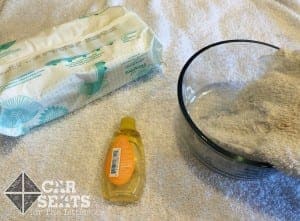
Assemble what you need in advance: the seat, a bowl of fresh tap water, a bottle of gentle soap, baby wipes, and clean rags.
The quicker you start working, the better chance you have of salvaging your child’s seat. It might be tempting to stick that seat on the porch until tomorrow, but it’s not worth the risk, especially if you can’t afford to replace the seat. Assemble what you need in advance: the seat, a bowl of fresh tap water, a bottle of gentle soap, baby wipes, and clean rags.
2. Remove Gross Matter

Use a baby wipe, and pick off any substance that is removable without rubbing, scrubbing, or using a cleaning solution.
Use a baby wipe, and pick off any substance that is removable without rubbing, scrubbing, or using a cleaning solution.
3. Wipe down the harness
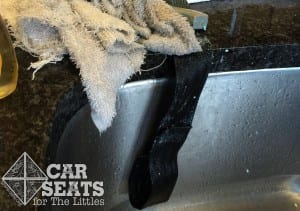
Using a soft cloth and cool water, wipe off the harness. If water isn’t going to cut it, use a gentle soap.
Using a soft cloth and cool water, wipe off the harness. If water isn’t going to cut it, use a gentle soap. “GENTLE” AND “NATURAL” ARE NOT THE SAME THING. (see below)
4. Clean the Crotch Buckle
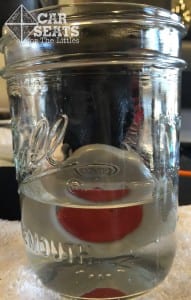
Invert the buckle in a cup of tap water, keeping the webbing out of the water. Swishing it around will dislodge anything trapped in the mechanism.
Invert the crotch buckle in a cup of tap water, keeping the webbing out of the water. Swishing it around will dislodge anything trapped in the mechanism.
5. Sun and Fresh Air
If the harness is removable, lay it flat in the sunshine for a few hours. Any remaining odor is likely to dissipate.
6. Rinse and Repeat
If you’ve followed these steps and your harness still has an odor or significant staining, try, try again. In some cases, the harness is replaceable for a small fee from the company. If you still have staining or odor, consider calling your manufacturer to ask if you can purchase a new harness for your existing seat.
It can be comforting to realize that manufacturers understand that children are, well, wet. They leak unmentionable fluids from impolite orifices. They spill things. They have accidents. Car seats can be intended to last a child many years. A harness that melts like sugar the first close encounter it has with a sippy of apple juice would not be a practical design for a product intended for children.
Unsafe Cleaning Methods
While the harness is hardy and durable, there are certain DO NOTS that you must keep in mind when cleaning your child’s restraint.
1. DO NOT: Ever, Ever, Ever Place a Car Seat Harness in the Washing Machine.
Sure, it seems like a practical idea, and it’ll come out sparkly clean, no doubt.
So, why can’t you do this? The answer lies in the tensile strength of the webbing. Car accidents hurt people because, among other things, of the short amount of time between traveling at whatever speed you may be traveling, and coming to a full stop. Restraints serve the purpose of slightly elongating that period of time (Called ‘ride-down time’). The webbing (material out of which the straps are made), specifically, will stretch, in a crash, reducing the amount of force transmitted to the body of the child. Spinning those harness straps around in the washing machine will prematurely pull all the stretch right out of the harness and take away that increased ride down protection they provide your child.
2. DO NOT: Use Abrasives to Clean the Harness.
No matter how tempting, please don’t go at the harness with steel wool. You’ll chew up those delicate fibers, and while an individual broken fiber may not mean much, a whole bunch of them will eventually weaken the restraining capacity of the harness.
3. DO NOT: Use Harsh Soaps.
If soap is permitted by the manufacturer in cleaning the restraint, always choose a gentle soap.
GENTLE AND NATURAL ARE NOT THE SAME THING.
I’ve had parents earnestly tell me, “Well, I live naturally, and I clean everything I own with vinegar. How could vinegar possibly hurt a car seat? It’s all natural!”
Natural Cleaners?
While as an aside, I would like to point out that many things are natural, like poison ivy and small pox, but not necessarily desirable, the primary point is that natural does not necessarily mean gentle. Vinegar, specifically, is an acid, and a rather h3 one.
The pH scale measures the concentration of hydrogen ions in solution. A neutral pH is 7.0, and what you would expect your drinking water to measure, if you were so inclined. (Human blood is around 7.35-7.45). Common household vinegar runs around 2.3-3.0 pH depending on which of the numerous available articles on vinegar available on the internet you consult. In comparison, hydrochloric acid (dependent on molarity and other things, of course), runs around 1.0). Lemon juice is a 2.0.
On the other end of the scale (>7.0-14), we have what are known as ‘bases’. A well-known example of a base is household bleach, which has a pH of 12.6. Another common household cleaner, Borax, has a pH of 9.3. And the most common household base, which we all know as a quick pinch solution for a bad case of indigestion, is baking soda, with a pH of 8.3.
It’s important to remember that the pH scale is logarithmic, so these differences in numbers are not small potatoes. The difference between 7.0 and 2.0 is not ‘5’ but 10 to the fifth power.







